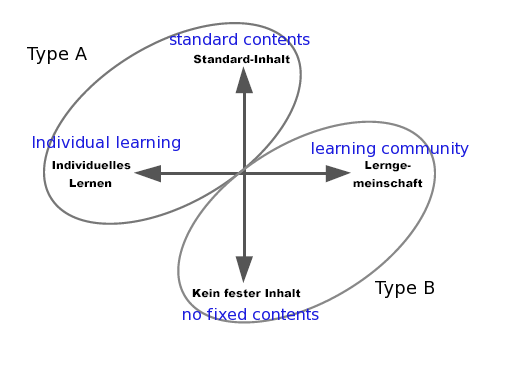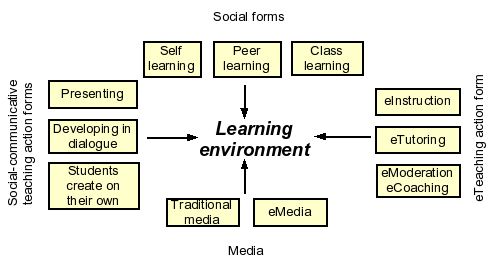E-learning
This article or section is currently under construction
In principle, someone is working on it and there should be a better version in a not so distant future.
If you want to modify this page, please discuss it with the person working on it (see the "history")
Don't know how I will write the initial article for this. Either it will be very long or I will factor out different issues. -- DSchneider
- As opposed to the computer-based training of the 1980s, the term e-learning is most frequently used to refer to computer-based training which incorporates technologies that support interactivity beyond that which would be provided by a single computer. Wikipedia:E-learning
- In our view there are 2 kinds of defition, E-Learning is either:
- a conceptually simple form of content-based computer-based training (and that shows in "e-instruction standards" like SCORM) plus addition of some e-tutoring.
- any form of learning that makes use of information and communication technology.
History
See also: educational technology
- If one looks at modern content oriented main-stream e-Learning one can not avoid thinking that e-learning has been invented in the early sixties.
- [Who invented the term ??]
- In the mid-nineties, so called learning management systems came into existence.
- In the early 2000, SCORM and IMS data standards, in particuler the IEEE Learning Object Metadata Standard (LOM), IMS Content Packaging (and associated IMS Simple Sequencing) became sort of industry standards and also have been adopted by some decision makers and funding agencies in academia.
- In the mid 2000s, instructional design seems to be back. This shows in standards like IMS Learning Design or numerous publications on e-learning that focus on serious instructional design methods and instructional design models.
- At the same time, in academina, content-orient LMS have lost a lot of ground against LMS systems like Moodle, Groupware, weblogs, C3MS that favor more activity-based (e.g. socio-constructivist, situated pedagogies.
Typologies
See also the article on educational technology that introduces other, more general typologies.
Schulmeister's type A and B
Schulmeister (2005) makes a distinction between:
- e-learning type A based on "manageable" contents that can easily made explicit via standardized learning objects and individual self-learning .
- e-learning type B focussing on a high percentage of complex contents based on implicit knowledge and that has to acquired through learning community of practice communities.
In terms of interactivity one also could talk about "internal" (type A) and external person-to-person interactivity. However, a lot of type A e-learning is not really interactive.
- Schulmeister's e-learning types A and B (from Schulmeister 2003, text in blue by DSchneider)
More generally Schulmeister (2005:486) makes a distinction between 6 didactic descriptors:
- E-learning type (see above)
- Pedagogical scenario
- Learning model, see learning theory
- Learning environment and learning unit
- Learning object
- Interactivity of learning objects
Euler and Seufert's e-galaxy
Euler (2004) presents a conceptual framework with building blocks for "e-learning supported learning environmnets".
- Source: Euler, D., Seufert, S. & Wilbers, K. (2004) [1]
Debates
What can we do with e-learning ?
While e-learning is fairly well accepted in areas where CBT survived well, i.e. low-level training in industry and the military, the value of e-instruction-oriented models are hotly debated. It is interesting to notice that strongest criticism comes from the instructional design community and not from constructivist practicioners and theories who simply tend to ignore this form of educational technology.
E.g. see Merril (in press), who as typical "main-stream" instructional designer always loudly claimed that "Information is not Instruction" makes it a program to ... "avoid enervative, endless, or empty e3-learning (pronounced 3 sub-three learning) and replace it with effective, efficient, and engaging e3- learning (pronounced e to the third power learning)".
Change management
A lot of debates around e-learning (as well as any sort of educational technology often refers to pedagogical innovation issues and change management in particular, both in order to explain "why certain things don't happen as they should" and how "to make things happen".
Standards
Pedagogical data standards
- IMS Simple Sequencing favoring a mastery learning design
- IMS Learning Design favoring activity-based designs
Meta-Data and packaging standards
- IMS Content Packaging defines how to package a content for distribution.
- Learning Object Metadata Standard (LOM, which is now a IEEE standard) allows to describe a pedagogical on-line resources with metadata.
System's standards
- SCORM pusblishes series of "standards" that are recommendation on what an LMS must be able to do. Current versions are usually based on IMS Data and packaging standards.
- IMS General Web Services to allow for interoperability of various systems. E.g. in some future you may be able to play a content hosted a learning management system within some more creative plateform (like this Wiki).
See also: Learning management system
Major players
References
- Euler, D., Seufert, S. & Wilbers, K. eLearning in der Berufsbildung [PDF, 126 KB]. In Arnold, R. & Lipsmeier, A. (Hrsg.): Handbuch der Berufsbildung. 2004 (in Druck). A preprint is available
- Euler, D. Didaktische Gestaltung von E-learning-unterstützten Lernumgebungen (2004), in Euler, D. & Seufert, S. (Hrsg.) E-Learning in Hochschulen und Bildungszentren. München: Oldenbourg, 223-242.
- Merrill, M.D. (in press) E-Learning: Lessons Learned, Challenges Ahead (Voices from Academe and Industry). S. Carliner and P. Shank, Pfeiffer/Jossey-Bass. Preprint: http://cito.byuh.edu/merrill/text/papers/e3%20learning.pdf
- Driscoll, M., Carliner, S. Advanced Web-Based Training : Adapting Real World Strategies in Your Online Learning, Pfeiffer. ISBN 0787969796
- Schulmeister, Rolf (2003), Modellversuch Lehrqualifikation für Wissenschaft und Weiterbildung, Abschlussbericht, Interdisziplinäres Zentrum für Hochschuldidaktik, Universität Hamburg. [2]
- Schulmeister, Rolf (2003b), Lernplattformen für das virtuelle Lernen. München:Oldenbourg
- Schulmeister, R. (2005). Kriterien didaktischer Qualität im E-Learning zur Sicherung der Akzeptanz und Nachhaltigkeit. In D. Euler & S. Seufert (Hrsg.), E-Learning in Hochschulen und Bildungszentren, München: Oldenbourg, p. 487.

